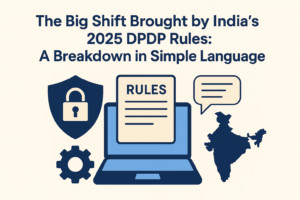India’s New Data Protection Rules Are Finally Here — And They’re About to Change How the Country Handles Privacy
India has been talking about a strong privacy law for years, and now it’s finally taking shape. With the government notifying the Digital Personal Data Protection Rules, 2025, the DPDP Act moves from being a promise on paper to something that actually has to be followed in real life.
This isn’t just another policy update. These rules will touch every app we use, every platform we trust with our information, and every organisation that handles our data. Here’s a calm, clear look at what they actually mean.
A Slow Start… But a Clear One
Instead of pushing everything at once, the government has rolled out the Rules in phases, giving organisations time to get their act together.
A few things—like the basic structure of the Data Protection Board—kick in right away.
Things like Consent Manager registration take a year.
And the heavier obligations—breach reporting, notices, data deletion, children’s data rules—get an 18-month runway.
This staggered start is actually helpful. It avoids panic and gives companies space to build proper systems instead of patchwork fixes.
You Can’t Keep Data Forever Anymore
One of the biggest changes is simple but powerful:
No more endless data hoarding.
Organisations have to:
- keep your data and processing logs for at least a year
- and then delete it if they don’t need it anymore.
Nothing fancy. Just common sense. But for many Indian companies that have been storing everything for years because “maybe we’ll need it someday,” this will be a major shift.
A Breach? Tell People. Fast.
Data breaches have become almost routine, and the silence from companies has often been worse than the breach itself.
The new rules insist on:
- telling the Data Protection Board
- telling the people affected
- doing it quickly
- and following up with a detailed report soon after
This is one of the most important protections for users. If your data has leaked, you deserve to know—immediately—not months later.
Stronger Care for Children
Children’s data gets a separate layer of protection.
Apps and websites will now need to build systems for verifiable parental consent.
The rules also tightly restrict real-time tracking of children, allowing it only when safety truly demands it.
In a world where kids are spending more time online than ever before, these protections matter.
Data Leaving India Will Face More Checks
The Rules don’t block cross-border data transfers entirely, but they do tighten the gate.
Significant Data Fiduciaries—big companies or those handling sensitive, large-scale data—will face extra responsibilities and more scrutiny.
This is an area that will evolve. A government committee will shape the final contours over time.
Security Isn’t Optional Anymore
“Reasonable security measures” is no longer an empty phrase.
Organisations now have to establish:
- encryption
- access controls
- regular audits
- breach response systems
- masking and logging practices
- and continuity plans
Basically, what should have been done years ago will now be mandatory.
The Board Is Coming — And It Will Have Real Teeth
The Data Protection Board will soon start functioning.
It won’t just be a symbolic body.
It can hold hearings, call out non-compliance, and impose substantial penalties.
For a long time, India had a privacy law without a regulator. These Rules fix that gap.
A Quiet but Important Line About AI
Buried in the Rules is a thoughtful requirement:
Companies that use algorithmic or AI-driven systems must make sure these systems don’t harm people’s rights.
It’s a small line today, but it places India squarely in the global conversation about responsible AI.
So, What Does All This Mean?
It means India is finally taking privacy seriously.
For users:
You get more control, more transparency, and quicker alerts Postwhen something goes wrong.
For organisations:
It’s time to clean up data practices, update policies, train teams, and stop treating user data like a never-ending vault.
For the digital economy:
Trust becomes a real competitive advantage.
Where Should Companies Begin?
Here’s a simple plan:
- Map all the personal data you store.
- Fix your consent notices.
- Set up breach-response processes.
- Build parental-consent systems if your platform deals with minors.
- Start planning for the one-year retention rule.
- Strengthen your security controls.
The 18-month window sounds long, but it won’t feel long.




